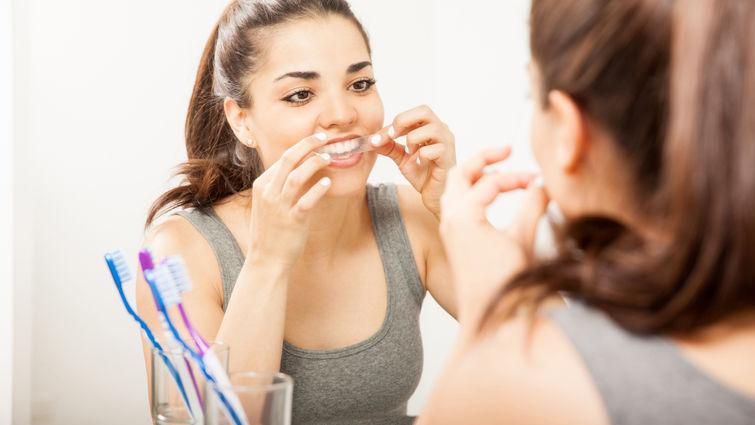
It’s easier to face the world with a good-looking smile, and proper dental hygiene, including, teeth-whitening, can have a positive impact on your self-confidence — and, by extension, the way others perceive you.
So Ran Kwon, DDS, MS, PhD, MS, Director, Student Research, Center for Dental Research, at Loma Linda University School of Dentistry, offers seven tips for teeth-whitening while keeping tooth safety in mind.
-
Consult with your dentist for best teeth-whitening options.
There are several reasons teeth lose their natural whiteness. A dental provider will examine your teeth and provide a tooth color analysis that includes the reason your teeth have darkened, the fact that existing restorations may not change color, and recommendations for a tooth-whitening regimen that is tailored to your needs. Two categories of whitening treatment supervised by a dental provider include repeated use of teeth enfolding trays at home or in-office treatment using higher bleaching concentrations that may also be activated with light. According to Kwon, the higher in-office concentrations whiten the teeth faster, but the ultimate tooth color will be the same with either method.
-
Over-the-counter products are good alternative whitening options.
Once you have consulted with your dental provider, over-the-counter products such as whitening strips found in any local supermarket offer a whitening alternative. They are available in different concentrations, and individuals should follow the manufacturer’s instructions. Kwon says the strips do work but cautions against overuse of these products. Studies have shown that teeth whitening agents may cause a reduce teeth’s firmness. Teeth whitening may also cause subtle surface changes on existing restorations, says Kwon, however additional studies are needed to evaluate the changes. Kwon encourages following the manufacturer’s suggested frequency.
-
Be mindful of home remedies.
A variety of do-it-yourself teeth-whitening options appear on the internet, Kwon says. Some of those options avoid chemicals; however, current studies show that natural ingredients — such as strawberries, coconut oil and charcoal — may remove superficial stains but do not change tooth color.
-
Refrain from high-colored foods and drinks.
Your beautifully whitened teeth can be maintained. Sorry, coffee lovers, but it’s one of the worst culprits for teeth staining. It’s best to avoid drinks such as coffee, sodas or sports drinks rich in color immediately after whitening. Also, highly acidic foods should be avoided following teeth-whitening such as oranges and strawberries. According to Kwon, it takes time for saliva to create a natural protective coat around tooth surfaces after teeth-whitening.
-
Consult a dentist if you suffer from tooth sensitivity.
It’s possible for individuals suffering from tooth sensitivity to have their teeth whitened, Kwon says. The important thing is to talk with a dental professional first. Most dentists will initiate a de-sensitivity regimen, including applying fluoride or potassium nitrate on the teeth for two weeks before bleaching.
-
Use teeth-whitening toothpaste and mouthwashes as maintenance.
Individuals who recently whitened their teeth are encouraged to maintain proper care with over-the-counter toothpaste and mouthwashes. These can be used as routine maintenance to remove stains, Kwon says. Whether you used over the counter bleaching strips or visited the dentist for teeth-whitening, whitening toothpaste and mouthwashes are safe to use.
-
Touch-Ups
Whether individuals use over-the-counter tooth-whitening products or seek care from a dental provider, the effects of either method typically last up to three years. Discoloration may accumulate slowly again but will not return to its original, pre-treatment shade, Kwon says. In order to maintain those pearly whites, she recommends touch-ups if you notice a relapse.
The two major adverse effects reported with tooth whitening are tooth sensitivity and gum irritation. Whitening-induced tooth sensitivity commonly is associated with cold, but often also occurs as a spontaneous sharp pain or “zinger” limited to one or few teeth. Typically, gum irritation is temporary and resolves quickly following tooth whitening. Consult your dental provider if sensitivity or irritation persists.
To avoid adverse effects on both teeth and gums, Kwon recommends consulting a dental provider who can determine the best treatment plan. Keep in mind that everyone’s teeth respond differently. Kwon says tooth-whitening not only whitens your teeth but, more importantly, motivates you to take better care of your teeth — and that will improve your overall oral health.
For more information and resources on teeth-whitening, visit the School of Dentistry’s dental clinics website.
